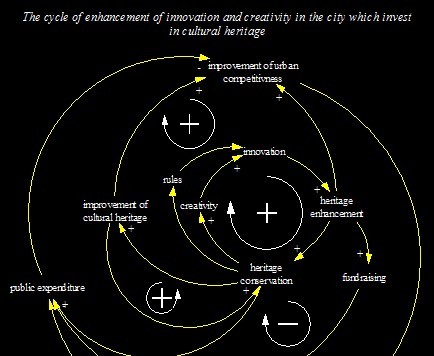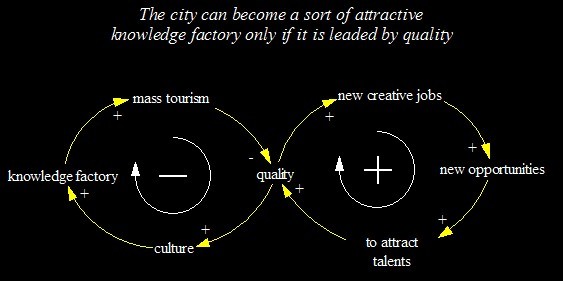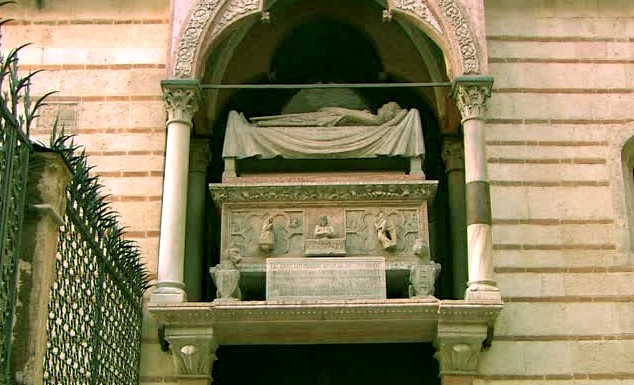Urban development via Cultural Heritage
A System Dynamics Based Model
Arnaldo Vecchietti
arnaldo_vecchietti@comune.verona.it
The new European planning for structural funds 2007-2013 has the improvement of territorial competitiveness among its chief goals. This approach can have extraordinary effects, if the European city will be able to create a new role for the European territorial cohesion.
Probably, those cities which will actuate effective programmes for the improvement of competitiveness and life quality of their citizens, will have to re-activate those dynamics of local governance, which used to characterize them in the past. These dynamics had allowed progress and democracy to grow together in Europe, but, after the success of national States, begun to unterritorialize. Therefore, they are now divided on different economical-institutional levels. Those cities which are looking for a new competitiveness, will probably have to draw their inspiration from their past, and will find, in the memory of what they used to be, the right inspiration to activate polycentric and multifunctional systems, with a better global cohesion, that we could call new urban Renaissance. In these places, where creativity and innovation will be able to grow, merging with economy and culture, in a sustainable way, we will have to create new collective guidelines, efficient solutions at a local and global level.

Of course, this is just a schematic vision, maybe too visionary, but, even with its limits, it is useful in focusing goals and in giving information on the direction to follow, during the next years. A direction made of quality, innovation, knowledge. A direction which, for those who deal with urban management, will be rich in satisfaction and in projects for the improvement of cultural heritage, for the creation of qualified spaces of the past (as former military and industrial architectures), where we can re-activate the propulsive function of the city of the future: the innovation function. Innovation and creativity need complex mechanisms of transmission, in order to allow a territorial system to guarantee the presence and preservation of the necessary income and occupation sources, which allow their existence and persistence. They need efficient and effective systems for the management of knowledge. They need a civil society, which is able to understand the stimuli of the global system, by tempering the preservation of traditions and sense of membership with the ability to change in a constant way. We have been telling each other for a long time, that the real challenges for our towns are change, innovation, the creation of favourable places to create effective inter-relations between economical-social systems and cultural constructions. Nowadays, we can be sure that these constructions determine and influence results and contents, therefore, we have to work on them, in order to change our cities.
During the last few years, the interest in culture has been growing in Europe, but in an exploitable way which has to do with the growth of a phenomena: the mass tourism, which turned the city into a generic commodity. Many cities decided to turn their territories into a place of general consumption. These cities sell tourists useful goods at a low price; the triumph of a low-quality market settles down, pressed by an endless competition.

At the basis of this vision, there is a fundamental shortsightedness, due to the lack of understanding for the new processes, which turned Europe into one of the most extraordinary social and human environments, for the production of new ideas, of beauty and of life quality. The model of the tourism town, is that of a thematic park for paying visitors, where everything is fake. The citizens of this tourism city, are turned into owners-maintenance men, unable to live the sense of their city, interested in the cultural dimension, just when they also play the role of tourists. The effects of that on European cities are clear: separation between city and suburbs, growing compulsive consumptions by tourists, anomy of citizens, decay of the historical urban fabric, continue decline of the quality of services, senseless proliferation of rubbish markets, denying the sense of the same culture they would like to represent, constant threat to the supportability of the cultural and environmental heritage of the city. This kind of urban development, if we can call it this way, is based on income an preservation, more or less clever, of the existing thing. It is addressed to the past, therefore it sees every kind of innovative cultural expression as a threat. How can a society based on such principles face the challenges of innovation? What does all of this have to do with the story of the culture which created our most beautiful cities? Can we, as citizens of walled cities, build our future by using innovation and creativity, putting the touchable elements of our cultural heritage to good use? Is it just a utopia?
I don’t think this is just a utopia. Nevertheless, we have to explain which are the independent and dependent variables.
The role of culture in the process of realization of the Lisbon strategy, is the independent variable, and regards much more than the tourism entertainment. As our history teaches us, the role of cultures doesn’t exhaust itself in the more or less cultivated pastime, but has to be searched in its function of social activator, of extraordinary moment of catalysis of thoughts, and its ability to turn it into a project of fascinating, shared sense, able to create and give sense of identity and context. In the scenario of the Lisbon strategy, culture becomes one of the factors creating the chain of value, the main channels that can be used to declare and attest a shared social orientation towards the new, the different, the unexpected.
Culture becomes part of the core innovation and core creativity, as well as scientific research and technology, having the same dignity of these “fundamentals” of the rising economy of knowledge. In order to turn our cities into “cities of innovation”, first of all we must turn them into culturally alive cities, that put their heritage to good use, that are strongly proposing, international as calling, able to give continue opportunities and stimulating experiences, humanly and intellectually qualifying, strongly motivating to a personal investment in new competences, to their citizens, in particular to young persons.
The real challenge is therefore the creation of a new culture, and the integration of it into the existing heritage, which should be fed by it and, at the same time, act as a culture medium, where our productive system can search for new ideas, which should trigger a complex but essential metabolism process. Ideas to realize competitive innovation.
The post-industrial competitive arena, issues new challenges, which must be faced by using adequate management models. The challenges of the society of knowledge, call for new kinds of horizontal integration between different nozzles, which are often far from each other, but characterized by strong, and often unexpected, complementarity of strategies of production and innovation. On this basis, rises the model of what we can call evolved cultural district: a model, where the dimension of the system calls for a complex integration among a quantity of acting factors, as public administration, entrepreneurship, the educational system and University, cultural operators and the civil society. A model which faces the new challenges of the Lisbon strategy, as regards its innovative forms of coordination towards a common strategic vision, aimed to the production and spreading of knowledge.
This is not an abstract model: during the last few years, all over the world, we can see a proliferation of new experiences, which reflect this logic and show the incredible richness of possible configurations. These experiences prefigure a new mechanism of endogenous growth, where cultural innovation means innovative system ability, through the complementarity with the scientific and technological innovation, by creating new resources for the cultural production, improving, at the same time, the quality of life and the attraction power of the local system.

How can we create a local development “hauled” by culture?
The cities could experience an extraordinary relaunching, if they were able to use the card of talent-attraction in a clever way: which creative personality wouldn’t like to spend its work-time in dynamic, open-minded places, rich in professional opportunities? Our cities would benefit from radical projects of productive reorganization, culturally mediated, for example by using part of their former military or industrial spaces as sophisticated incubators of scientific-cultural innovation, able to hold a dialogue with the productive system, University and the civil society. These cities, by investing in a wide and systematic strategy of creation of experience-competences and opportunities for citizens, could create an economical basis which can self-support the local development and trigger the development of new creative jobs and new kinds of entrepreneurship, by using the industrial and/or archaeological industry heritage, as a part of the public investment for this goal. Of course, this option is not proposed by the market. The pressure to reuse spaces to reconvert or re-functionalise, in merely residential or commercial terms, is so huge in our cities, that it becomes essential to define the priority objectives of innovation and creativity, by automatically associating them to every single project of change of use. All of this must be inserted in a urban plan, where reuse prevails over the suitable for building.
The success of the models of evolved cultural districts, is finally based on the ability of governance of the processes of accumulation of the new forms of intangible capital: the human and informative capital, connected to the production of new knowledge and to their individual and collective strengthening; the social capital connected to the subsidence of rules of behaviour allowing people and the community to create forms of intelligent intermediation between their own interest and that of a wide community; the identity capital connected to the creation of a symbolic and ideal inventory, identifying the local system and able to be applied to handiworks, to the experiences and lifestyles that it produces. No mechanical transfer of models which had success somewhere else, included those of success of evolved cultural district, can work in a context , where citizens can reach and/or use complex information and competences, to relate themselves in a constructive and cooperative way, even when there are potential clashes of interests on the destination of collective resources, to identify themselves in a project of shared sense, which “speaks” not only to the involved persons, but also to those who live and work in other contexts, with other canons of sense. The opposite of particularistic localism, dull and neo-tribal, which encircled many fragments of our territories.
We need to realize a social strategy of investment on the individual and collective human development, and to accomplish radical changes. In an economy that is founded on knowledge, the real and crucial infrastructure, is the dimension of the mental space of people. If I don’t have enough competences and experience to appreciate the quality of life in places that are full of sense, to understand the culture of a place or handiwork, how can I give some value to the experience of visiting or living in urban centres, where to enjoy the right context of productivity, sociality, accessibility, liveability?
Only if I gain this competences and integrate them in my behaviour repertory, in an harmonic way, I will be able to give the right value to the experience of living in a high-quality place, and I will be able to present it to the people who must guarantee its preservation.
If this happens, I trigger a virtuous circle of beauty, talent and knowledge: the competence of clients brings to a higher competence of owners and administrators of the cultural and historical heritage of the city, which triggers the competence of citizens and tourists, and so on. The virtuous circle attracts new quality-consumers, and causes new talents to use their creativity in this field, which is rich in economical and professional satisfactions, the market grows, the professional education is improved, we gain a good reputation, and so on. This way, the city becomes a workshop of innovation and creativity, that was typical for the Renaissance society. The mental space of producers and consumers grows, tends to look for and house more information and competences, to trigger more expert and motivate evaluations and behaviours, giving the basis for the creation of a bigger economical value, in a geometrical way. But, if these competences are not created and consolidated, the clients will only be interested in having fake goods for a low price. A low-use and low-access maintenance, loses its heritage value of the good, and owners and administrators lower the quality of offered solutions, adding false glitters, and condemning a potential flourishing economy to the decline.
The dimension of the people’s mental space is therefore the critical infrastructure of new economy, which makes us measure the potential of urban development on the percentage of readers, of exhibition visitors, of the level of technological literacy, of the quality of comfortable life, of the extension of the quality of networking in local communities, with other context, innovative and open to new ideas. In absence of this base competences, we don’t have the conditions to create value. A society and economy that are still inside an out-of-date mass consumption, which adulates the consumer and convinces him to go along with his desires (treating him like a child, without any responsibility), instead of triggering his curiosity for self-improvement, of discovering its unexpressed potential, of the research for new motivating and fulfilling experiences, doesn’t have any chance to play a lead role in the new European scenario. This Europe denies strategies of collective stupidity, makes its citizens think, with courage, confidence, excitement, about how to reactivate the cycle of enhancement of innovation and creativity in their cities.
|